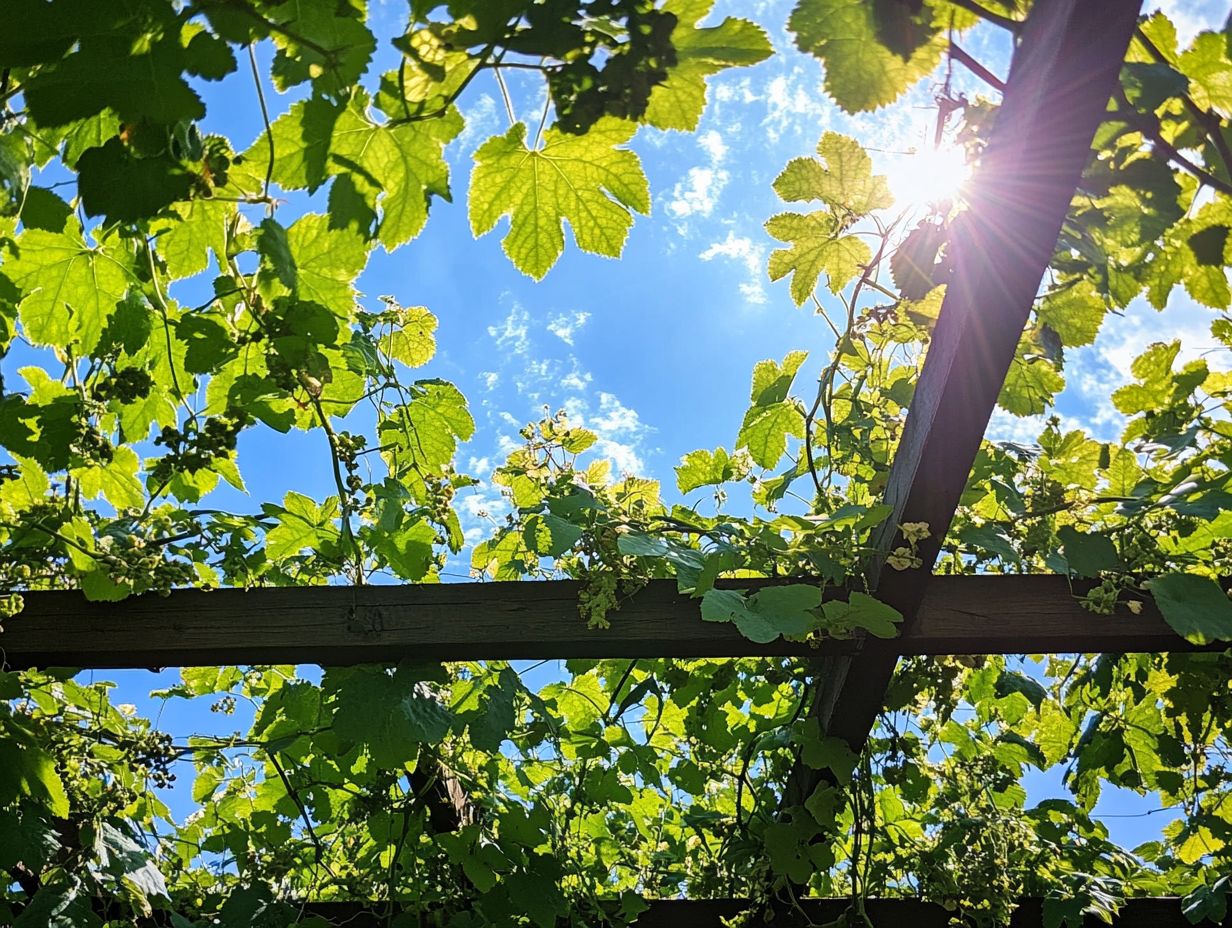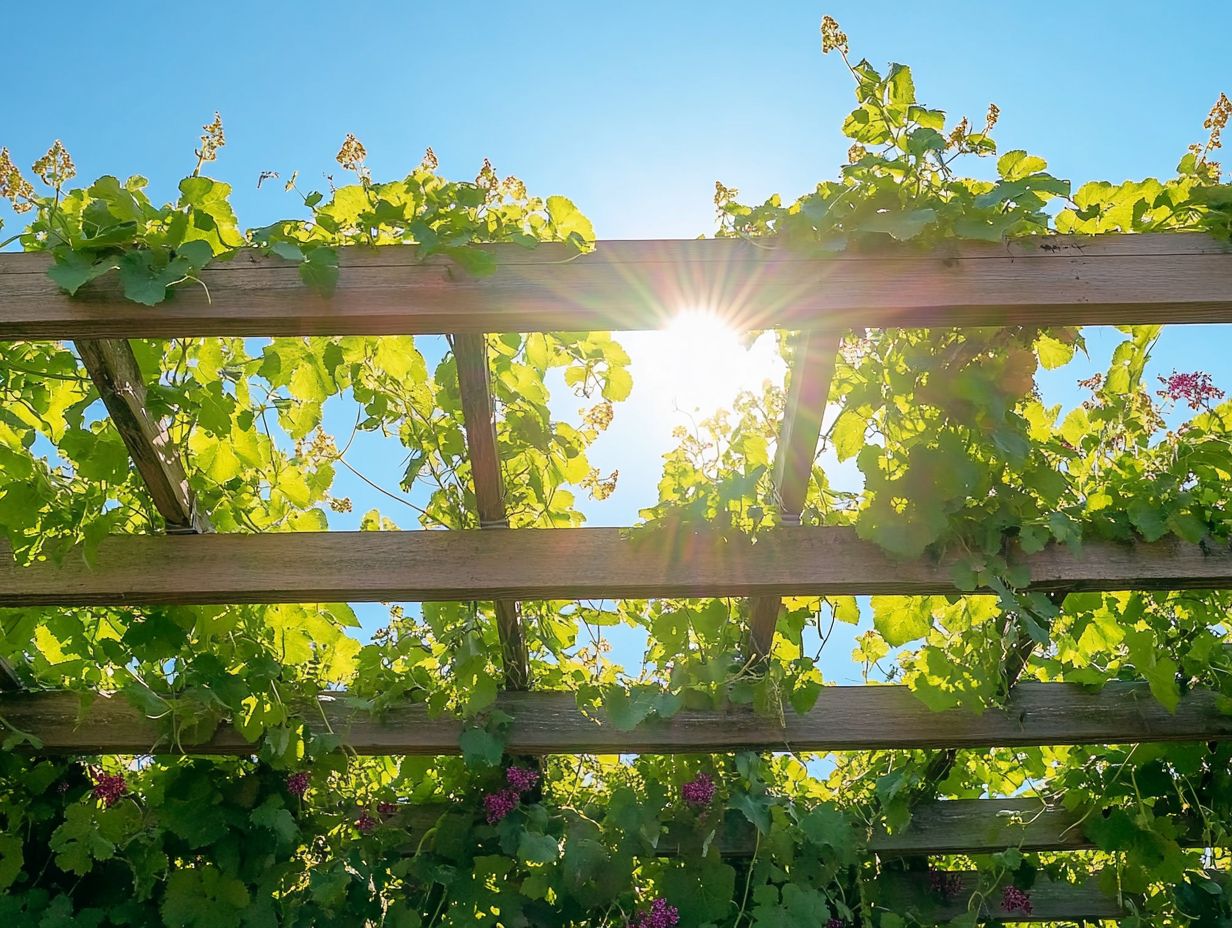5 Drought-Resistant Vines for Vertical Spaces
If you’re eager to infuse vibrant greenery into your vertical spaces without the hassle of constant watering, look no further drought-resistant vines are your ideal solution.
Explore five stunning options:
- Bougainvillea
- Arizona Grape Ivy
- Clematis
- Honeysuckle
- Passion Flower
- Trumpet Vine
All of which flourish in dry climates.
Understand how to select the perfect vine for your garden, care for them properly, and seamlessly integrate them into your landscape design.
Prepare to transform your outdoor space with these resilient beauties, effortlessly enhancing your surroundings.
Contents
- Key Takeaways:
- 1. Bougainvillea
- 2. Arizona Grape Ivy
- 3. Clematis
- 4. Honeysuckle
- 4. Passion Flower
- 5. Trumpet Vine
- How to Choose the Right Drought-Tolerant Vine for Your Vertical Space?
- Frequently Asked Questions
- What are some benefits of using drought-resistant vines for vertical spaces?
- What are the top 5 drought-resistant vines for vertical spaces?
- How do I care for drought-resistant vines in vertical spaces?
- Can drought-resistant vines be grown in all types of vertical spaces?
- Do drought-resistant vines attract any pests or diseases?
- Are there any alternative options for drought-resistant vines in vertical spaces?
Key Takeaways:

- Choose a drought-resistant vine for your vertical space based on factors such as sunlight, soil type, and maintenance level.
- Proper care and maintenance, including regular watering and pruning, are crucial for the success of drought-resistant vines in vertical spaces.
- Incorporating drought-resistant vines into your garden design not only adds beauty and color but also provides environmental benefits such as water conservation and increased biodiversity.
1. Bougainvillea
Bougainvillea is a vibrant and drought-tolerant vine, celebrated for its stunning flowers that can instantly infuse any garden with color. It s perfect for those living in dry climates where water conservation is essential.
Explore numerous Bougainvillea varieties waiting to beautify your garden! Each offers unique hues, from deep magenta and fiery orange to elegant pastels.
Hailing from the tropical regions of South America, this versatile plant thrives in sunny environments and flourishes best in hardiness zones 9 to 11. These striking blooms elevate your outdoor spaces and adapt beautifully to dry conditions.
Typically blooming from spring through fall, their vibrant displays create an enchanting atmosphere, enhancing the overall design of your gardens and patios while attracting pollinators. It s a choice that seamlessly blends beauty with biodiversity.
2. Arizona Grape Ivy
Arizona Grape Ivy is another excellent option for adding vertical greenery. This plant thrives in similar conditions, offering a lush appearance with minimal care requirements.
3. Clematis
Clematis is a remarkably versatile climbing vine that flourishes in various conditions, making it an exceptional choice among drought-resistant plants for introducing vertical lines and vibrant greenery to your landscape.
With a plethora of varieties at your disposal, this plant can cater to any gardener’s aesthetic. Whether you’re drawn to the delicate flowers of Clematis montana or the bold blooms of Clematis ‘Jackmanii’, there s something for everyone.
Once established, the care requirements are generally minimal, involving just regular watering and occasional pruning. These climbers excel as privacy screens, creating lush, green barriers or stunning focal points that capture attention and enhance your garden’s overall design.
4. Honeysuckle

Honeysuckle is a fragrant and drought-tolerant climbing vine that not only offers beautiful blooms but also serves as a natural privacy screen in your garden, elevating both its aesthetics and functionality.
With over 180 recognized species, honeysuckle boasts an impressive variety of flower types, from trumpet-shaped blossoms to delicate tubular forms, each releasing a delightful scent that draws in pollinators.
You ll find prominent species like the Japanese honeysuckle, which bursts forth in vibrant yellow and white, and the coral honeysuckle, showcasing a striking red hue.
Their growth habits are just as diverse; some spread gracefully along fences and trellises, while others may need a little more structured support. By incorporating these varied varieties into your garden design, you not only add visual interest but also create effective natural barriers, crafting secluded spaces for relaxation in your outdoor haven.
4. Passion Flower
Passion Flower is an exotic climbing vine that stands out with its intricate flowers. It elevates any drought-tolerant garden design.
This vine comes in many species from the tropical and subtropical regions of the Americas. Some varieties, like Passiflora edulis, are prized for both beauty and delicious fruit.
Understanding their care needs, like optimal sunlight and moisture levels, is key to fostering healthy growth. These vines bloom from spring to fall, bringing vibrant color to your garden.
They are excellent for vertical gardening, adding visual interest to fences or trellises and transforming your outdoor space.
5. Trumpet Vine
5. Silver Lace Vine
Trumpet Vine features stunning trumpet-shaped flowers. It enhances your garden’s beauty and attracts hummingbirds and other pollinators.
This resilient perennial grows vigorously, reaching heights of 20 to 30 feet depending on conditions. It thrives in well-drained soil and full sun, adapting well to various climates.
Proper vine training is essential. Secure it with trellises or arbors to encourage upward growth while controlling its spread.
Incorporating Trumpet Vine into your garden adds visual flair and creates a vibrant habitat for wildlife.
How to Choose the Right Drought-Tolerant Vine for Your Vertical Space?
Choosing the right drought-tolerant vine involves considering factors like sun exposure and plant size. This helps achieve both aesthetic appeal and ecological sustainability.
Geographic origin is crucial. Understanding hardiness zones the range of temperatures a plant can tolerate helps you select vines suited for your region’s climate.
Water needs are also important, especially in drought-prone areas. Some vines need little water yet offer lush coverage for privacy or decorative elements.
Align your choices with specific landscape designs to maximize functionality and visual interest.
What Are the Key Factors to Consider?

Evaluate key factors like sun exposure, hardiness zones, and water needs for optimal growth. This is vital for drought-resistant plants.
Consider your climate conditions, including temperature fluctuations and humidity levels, as these impact vine development. Soil type also matters; sandy soils drain quickly, while clay retains moisture.
Using proper vine training methods, like trellising, enhances air circulation and sunlight exposure. Strong varieties like Clematis thrive in sunny spots, while Passionflower excels in warm, humid environments.
How to Care for Drought-Resistant Vines?
Caring for drought-resistant climbing vines requires you to grasp their specific needs regarding sunlight and soil types. Understanding their watering routines is essential to ensure they thrive in your garden.
It s important to consider their growth habits and how they interact with neighboring plants. Their resilience to shifting weather conditions is also key. Regular watering, especially during the initial establishment phase, is vital; typically, these vines need deep watering every two to three weeks.
Enhancing the soil with organic compost can significantly improve drainage and nutrient availability. This is a boon for their overall health. Periodic pruning is also beneficial; it helps maintain their shape, encourages vigorous growth, and prevents issues like overcrowding.
By being mindful of these care practices, you can cultivate flourishing drought-resistant vines that require minimal upkeep while maximizing their beauty in your garden.
What Are the Benefits of Using Drought-Resistant Vines in Vertical Spaces?
Utilizing drought-resistant vines in your vertical spaces brings a wealth of advantages. They enhance the aesthetics of your landscape while promoting environmental sustainability and crafting effective natural privacy screens.
These vines contribute to reducing water usage and conserving resources. They also demand minimal upkeep, making them perfect for busy homeowners. For example, the hardy Clematis and the resilient Blue Trumpet Vine thrive in arid conditions while infusing your exterior walls with vibrant color and texture.
These plants also support biodiversity by attracting essential pollinators like bees and butterflies. By incorporating such vines into your landscape, you cultivate a lush, green environment that is visually stunning and ecologically beneficial!
What Are the Best Practices for Growing Drought-Resistant Vines?
To successfully cultivate drought-tolerant vines, embrace best practices that consider soil types and water requirements. Effective vine training techniques aim to maximize their growth potential.
Understanding each vine’s specific needs is crucial. For example, preparing well-draining soil enriched with natural material that helps plants grow enhances moisture retention and root systems. Adding mulch will maintain soil moisture and reduce weed competition.
Regular pruning promotes air circulation and light exposure, leading to healthier vines overall. By adjusting your watering schedules seasonally, you create an environment where drought-tolerant vines flourish, ensuring a vibrant landscape year-round!
How to Incorporate Drought-Resistant Vines into Your Garden Design?
Incorporating drought-resistant vines into your garden design elevates your landscape’s visual appeal. It also promotes environmental responsibility and enhances the functionality of your vertical spaces.
By thoughtfully integrating these resilient plants along trellises and fences, you create stunning focal points. This naturally draws the eye upward, making the most of your limited ground space. Vertical gardens beautify walls and serve as natural insulators for your home, lowering energy costs and providing habitats for beneficial insects.
Embracing drought-tolerant varieties fosters a diverse ecosystem, offering nectar and shelter for pollinators essential allies in maintaining a healthy garden.
Together, these elements create a harmonious balance between exquisite design and sustainability. Transform your outdoor space into a thriving oasis!
Frequently Asked Questions
We would love to hear your thoughts! Share your experiences or ask questions about growing drought-resistant vines.
What are some benefits of using drought-resistant vines for vertical spaces?
Drought-resistant vines use less water, making them eco-friendly and budget-friendly.
They also add beauty to your vertical spaces.
What are the top 5 drought-resistant vines for vertical spaces?
Here are five top drought-resistant vines: bougainvillea, clematis, trumpet vine, honeysuckle, and wisteria. For more inspiration, check out these unique drought-tolerant design ideas.
These vines thrive even in dry conditions!
How do I care for drought-resistant vines in vertical spaces?
Caring for drought-resistant vines is easy.
Water them regularly when you first plant them, and they ll need little to no water afterward.
Can drought-resistant vines be grown in all types of vertical spaces?
Yes! You can grow drought-resistant vines on trellises, walls, fences, and pergolas.
Just make sure they have proper support and good soil.
Do drought-resistant vines attract any pests or diseases?
Drought-resistant vines typically resist pests and diseases.
Keep an eye out for aphids or spider mites, which are easy to manage with natural solutions.
Are there any alternative options for drought-resistant vines in vertical spaces?
If those five options don t fit your needs, consider alternatives like climbing hydrangeas, passionflowers, or climbing roses.
Pick a vine that suits your climate!







